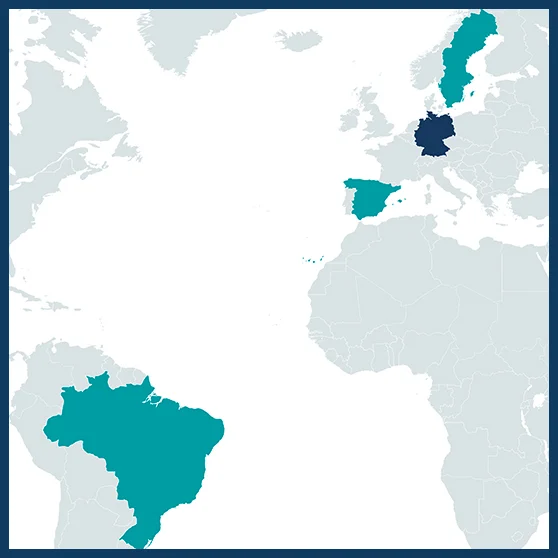01/04/2022 – 31/03/2025
€ 772,957
Mario Brauns
mario.brauns@ufz.de
Coordinator: River Ecology, Helmholtz Centre for Environmental Research, Magdeburg, Germany
Engineering, University of São Paulo, São Carlos, Brazil
Geosciences, Federal University of São João del- Rei, São João del-Rei, Brazil
Environmental Sciences, University of Koblenz- Landau, Landau, Germany
Evolutionary Biology, Ecology & Environmental Sciences, University of Barcelona, Barcelona, Spain
Ecology and Environmental Science, Umeå University, Umeå, Sweden

Restoration approaches to improve the hydromorphology of streams are increasing worldwide but often fail to recover good ecological status and biodiversity. Yet, the evidence for the dominant effects of hydromorphology on biodiversity and ecosystem functioning suggests that the strong potential for hydromorphological restoration is not fully explored in stream rehabilitation. It is argued that restoration often fails because it does not consider the spatial scales of stream hydromorphology that are most relevant to biodiversity and ecosystem functioning. Moreover, traditional indicators of restoration success based on the composition of biological communities may not show the same recovery trajectory as key ecosystem functions, such as organic matter decomposition and nutrient retention. RESTOLINK proposes a novel framework for evaluating restoration success by mechanistically linking hydromorphological heterogeneity at relevant scales, multi-group biodiversity, and the multifunctionality of stream ecosystems. We will apply this framework to streams across a broad latitudinal gradient from boreal to tropical biomes and will thus test how biome-specific factors such as climate, vegetation, and hydrology set the boundaries for local restoration responses.
RESTOLINK’s aim is to propose and test a novel framework for quantifying restoration success that connects hydromorphology with biodiversity and essential ecosystem functions. It builds upon three conceptual approaches grounded in hydraulic and ecological theory. In doing so, RESTOLINK will advise how the restoration of in-stream complexity must be designed to return freshwater biodiversity and ecosystem functioning to sustainable levels efficiently, thereby providing a blueprint for better restoration efforts. A unique aspect of RESTOLINK is the broad assessment of restoration efforts in freshwater ecosystems ranging from the Brazilian Cerrado to the boreal forest landscapes of northern Sweden. This allows testing whether ecosystems differing in regional biodiversity, key climate drivers, and underlying geologies respond similarly to restoration measures. RESTOLINK will benefit from the early involvement of stakeholders and the local administrations, ensuring that end-user demands will be targeted adequately in the project. Regular meetings with local administrations will also provide end-users and practitioners with information on what aspects should be considered in restoration projects. In addition to the organisation of interactive knowledge exchange workshops with practitioners, regular annual newsletters will be published. To target specific practitioners and public sector end- users, for example, those directly involved with water treatment and technology, environmental monitoring, and water resources management. The main aim of these activities is to transfer scientific knowledge to achieve the success of restoration projects in fluvial ecosystems.
Interlinking multi-group biodiversity, multifunctionality, and hydromorphological heterogeneity will advance the fundamental understanding of the functional role of biodiversity and contribute substantially toward a novel science-based management of freshwater resources. Applying RESTOLINK’s concept will link restoration actions (i.e., measures to improve stream hydromorphology) mechanistically to their intended outcome (recovery of biodiversity). This will help improve restoration efforts and establish indicators of ecosystem functioning. RESTOLINK expects that evaluating the functional response across biomes will help tailor indicators applicable over wider geographical ranges. Similarly, through cross-biome assessment, the project will be in a position to establish general guidelines for restoration that may prevent local authorities from engaging in efforts that are unlikely to be successful, given unique regional drivers of stream structure and functioning. RESTOLINK envisages a close collaboration with national and international stakeholders to collaborate with (e.g., local environmental agencies in each country to be involved or consulted (e.g., federal environmental agencies, European Topic Centre on Inland, Coastal and Marine waters, European Centre for River Restoration), and to be informed (e.g., environmental ministries).
The primary aim of RESTOLINK is to advise how the restoration of in-stream complexity must be designed to return freshwater biodiversity and ecosystem functioning to sustainable levels efficiently. Moreover, the project will establish ecosystem functions as indicators of early restoration success that can also be used to assess ecosystems’ functional status. Hence, RESTOLINK addresses three policy frameworks. The biodiversity strategy of the European Union for 2030 aims at restoring 25.000 km of European rivers to a free-flowing state to improve the threatened freshwater diversity and ecosystem functions. A deeper understanding of critical spatial and temporal restoration scales to improve biodiversity and ecosystem functions can be provided by RESTOLINK’s research. RESTOLINK will also establish indicators and provide recommendations about the sensitivity, variability, and applicability of functional indicators across biomes that can be.
Data will be collected in country-specific case studies, where sites will be studied that have been restored at least five years before the project starts. Restored reaches are compared with positive and negative controls, which allows for quantifying restoration success as either the deviation of a given restored site from the negative control or its convergence with the positive control. Our approach will enable us to identify the most effective management practice for each biome and allows us to quantify the physical conditions under which management measures are successful. Fieldwork is conducted in Sweden, Germany, Spain, and Brazil, respectively but guided by joint field protocols that allow the standardised collection of relevant data.
- VDI/VDE-IT, Germany
- São Paulo Research Foundation (FAPESP), Brazil
- Agencia Estatal de Investigación (AEI), Spain
- Swedish Environmental Protection
- Agency (SEPA), Sweden